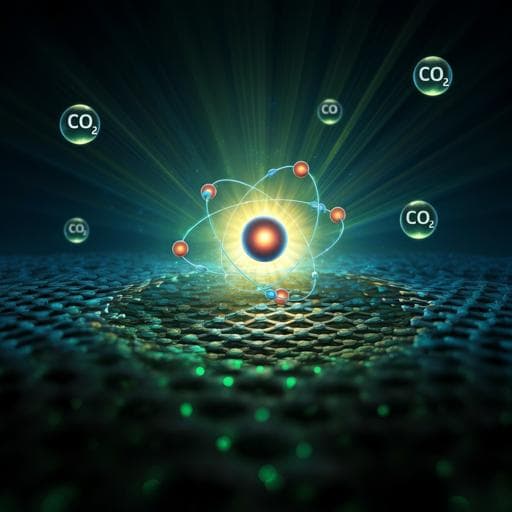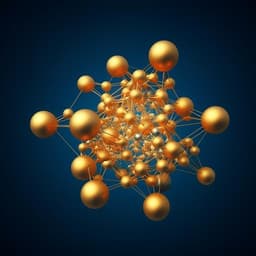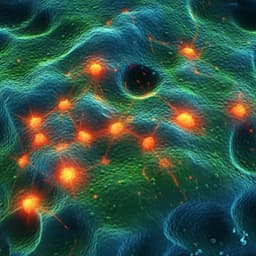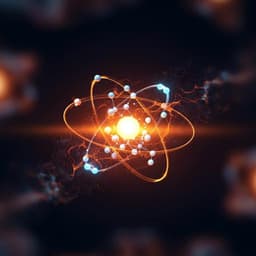
Chemistry
Dual Activation of CO₂ on a Single-Atom Photocatalyst for Efficient CO₂ Reduction
F. Sun, C. Li, et al.
Discover the groundbreaking research by F. Sun, C.B. Li, Q. Cheng, W. Zhang, W.X. Cheng, X.N. Li, and G.L. Zhuang on the novel photocatalyst Ti@C₄N₃, showcasing its exceptional stability and remarkable efficiency in CO₂ reduction, paving the way for innovative energy solutions.
~3 min • Beginner • English
Introduction
The study addresses how to achieve efficient photocatalytic CO2 reduction, particularly the challenging C–C coupling step required for forming C2+ products. Single-atom catalysts (SACs) often face difficulties due to isolated active sites and strong binding of C1 intermediates that hinder diffusion and coupling. The authors propose a Ti single atom supported on a 2D C4N3 substrate (Ti@C4N3) as a photocatalyst capable of dual activation of CO2 (thermal and photo-induced) and investigate whether two activated CO2 molecules can directly couple to form an oxalate intermediate, enabling C2 hydrocarbon formation under light irradiation.
Literature Review
The paper situates its work within the context of photocatalytic and electrocatalytic CO2 reduction research, noting common assumptions that CO is a necessary intermediate for C–C coupling to C2+ products and challenges for SACs due to isolated active sites and strong adsorption of intermediates. It references prior advances in SACs, MOFs, metal oxides, and carbon-based catalysts for CO2 activation and reduction, as well as time-resolved studies on C–C coupling intermediates on Cu. It highlights recent strategies such as defect engineering, dual metal sites, and photothermal effects, and points out remaining challenges in simultaneously activating multiple CO2 molecules and promoting direct C–C coupling on SACs.
Methodology
- Ground-state DFT: VASP 6.3.1 with PBE functional and PAW pseudopotentials for geometry optimization, electronic structure, and reaction mechanisms. HSE-06 hybrid functional used for band gap calculations; GW method used to assess temperature-dependent band gap renormalization.
- Stability analyses: Ab initio molecular dynamics (AIMD) at 500 K to examine thermal stability and total energy fluctuations. CI-NEB calculations to determine diffusion pathways and barriers for Ti atom migration/aggregation on C4N3. A solid–liquid interface model with a “slow-growth” approach to compute the free-energy profile for Ti leaching (elongating Ti–N bonds). Elastic constants (C11=C22=136.08 GPa; C12=8.96 GPa) calculated to test Born-Huang criteria; polar plots for Young’s modulus and Poisson’s ratio.
- Optical and carrier properties: Band-edge composition and band structures for pristine C4N3 and Ti@C4N3; optical absorption spectra; electron–phonon interaction captured via one-shot sampling of atomic Cartesian coordinates across temperatures 273.15–373.15 K in 10 K steps; evaluation of transition dipole strengths (P^2) and effective masses of carriers.
- Excited-state dynamics: Nonadiabatic molecular dynamics (NAMD) using Hefei-NAMD to extract photocarrier lifetimes by fitting P(t)=exp(-t/τ). Real-time TDDFT (rt-TDDFT) MD with TDAP to simulate light-induced dual activation of two CO2 molecules at 300 K (light-300K), 0 K (light-0K), and 300 K without light (no-light-300K). Charge analyses via Bader and Hirshfeld partitioning.
- Adsorption/activation: AIMD to monitor structural evolution (bond angles/lengths) of CO2 upon adsorption on Ti@C4N3; electronic structure analyses of d–π* back-donation (Ti d and CO2 π* matching).
- Reaction mechanisms: DFT+U (Ueff=3.79 eV) for transition state searches and energy barriers of CO2RR. Consideration of proton transfer and proton-coupled electron transfer (PCET) steps for single-CO2 and dual-CO2 pathways. COHP/ICOHP to analyze bond strengths in coupled intermediates.
- Data/software: Supplementary computations provided; VASP (commercial), TDAP and Hefei-NAMD (open-source).
Key Findings
- Structural and chemical stability: Ti atoms are strongly anchored at N3 hollow sites of C4N3. Ti aggregation barriers: first Ti migration barrier 2.38 eV; rate-determining step for Ti–Ti agglomeration 3.93 eV; overall aggregation endothermic by 4.79 eV, indicating high kinetic and thermodynamic resistance to aggregation. Leaching of Ti from NC site in water shows a free-energy increase to 2.47 eV at the reaction endpoint. Elastic constants C11=C22=136.08 GPa; C12=8.96 GPa satisfy Born–Huang criteria. Young’s modulus ~136.25 GPa; Poisson’s ratio ~0.066, indicating good mechanical stability.
- Electronic/optical properties: Pristine C4N3 is conductive (N 2p across EF); Ti@C4N3 becomes semiconducting with HSE-06 band gap Eg=0.97 eV; VBM mainly N 2p; CBM dominated by Ti 3d. Two pronounced absorption peaks at 327.77 and 529.61 nm, red-shifted relative to pristine C4N3 (peak at 275.40 nm), improving visible-light absorption.
- Temperature effects: GW-calculated band gap decreases with temperature (273.15–373.15 K). Transition probabilities (sum of squared dipole matrix elements) show minor temperature dependence. Effective mass: electrons ~4 me (temperature-insensitive); hole effective mass decreases with temperature; me and mh approach each other at higher T, potentially accelerating recombination. Photothermal effect can aid catalysis up to a point; maintaining me < mh up to 373 K supports higher activity.
- Carrier dynamics: NAMD yields photogenerated electron lifetime τ≈38.21 ps, allowing sufficient time for surface migration and redox before recombination.
- CO2 activation (single and dual): Single CO2 chemisorbs with Eads=−1.05 eV; AIMD shows bending from 180° to ~135° within 30 fs; C–O elongation to ~1.30 and 1.20 Å; Bader analysis shows catalyst donates ~0.65 e to CO2; Ti remains high-valent with ~2.31 e. Dual adsorption: the second CO2 is weakly physisorbed (Eads=−0.39 eV) and gains ~0.03 e, remaining largely unactivated in the dark.
- Light–thermal synergy for dual activation: rt-TDDFT MD under light at 300 K (light-300K) shows staged charge transfer: (0–20 fs) initial excitation and small charge flow; (20–60 fs) Ti donates ~0.05 e, substrate donates ~0.05 e to CO2-2, bending to ~152° and C–O1 stretching to ~1.35 Å with oscillations; (60–80 fs) further charge exchange with CO2-1 providing feedback, enabling CO2-2 to reach ~145° and longer C–O. Light-0K also activates but more slowly and less strongly; no-light-300K shows negligible charge transfer and structural change. Conclusion: photoexcitation is key to dual activation; thermal effects facilitate charge transfer via electron–phonon coupling.
- Reaction mechanisms (single CO2): After activation to CO2−, first PCET yields COOH (more stable than HCOO−). COOH → CO + OH has uphill 0.23 eV; OH to H2O via PCET barrier 0.40 eV; CO desorption requires 1.51 eV (RDS for CO generation). Subsequent hydrogenation proceeds through CHO rather than COH (barriers 0.11 vs 1.73 eV). CHO → HCHO (0.30 eV) is favored over CHOH (1.21 eV). Strong adsorption of HCHO (Eads=−2.26 eV) hinders desorption; hydrogenation of HCHO− → CH2OH (0.70 eV), then → CH3OH (0.65 eV), then → CH3 → CH4 via PCET steps; CH4 desorption Edes=0.56 eV. Overall, eight PCET steps produce C1 products; reported RDS barriers: 1.51 eV (CO), 2.26 eV (HCHO), 1.59 eV (CH3OH), 0.70 eV (CH4); CH4 shows highest kinetic selectivity. C–C coupling via typical CO-mediated routes is disfavored on this SAC due to strong adsorption and repulsion between C1 intermediates.
- Direct coupling of two CO2: CI-NEB finds direct CO2–CO2 coupling barrier 0.19 eV (easier than CO2 + H+ coupling, 0.23 eV), forming surface oxalate (OOCCOO) with strong C–C bonding (ICOHP −3.99) and strong Ti–O bonds (−2.82, −2.79), stabilizing the intermediate. Subsequent PCET steps lead to various C2 products. Representative barriers/energetics: formation of OOCCOOH (0.64 eV), cis→trans HOOCCOOH via proton transfer (0.94 eV), further hydrogenations and dehydrations lead to intermediates such as CHCOH and CHC; sequential hydrogenations yield C2H2, C2H4, and ultimately C2H6. Product energetics: desorption energy 2.56 eV for (COOH)2; overall barriers 1.71 eV (CH=COH), 2.02 eV (C2H2), 1.75 eV (C2H4), 1.09 eV (C2H6). The formation of HOHOCCOHOH is identified as the rate-determining step (barrier 1.09 eV; ΔGmax 1.57 eV). C2H6 via fourteen-electron reduction is the optimal C2 product.
Discussion
The findings demonstrate that Ti@C4N3 is a robust single-atom photocatalyst platform: Ti atoms are immobilized with high kinetic and thermodynamic stability against aggregation and leaching, and the host acquires a suitable band gap and visible-light absorption due to Ti 3d contributions to the CBM. Long photocarrier lifetimes support surface reduction reactions. Thermally, the Ti(IV) site with strong Lewis acidity back-donates to CO2 π* orbitals to activate one CO2 molecule; under illumination, photoexcitation drives additional charge transfer from Ti and the support to a second, initially physisorbed CO2, enabling simultaneous dual activation when aided by electron–phonon coupling at finite temperature. Mechanistically, this dual activation opens a low-barrier (0.19 eV) direct CO2–CO2 coupling pathway to oxalate, in contrast to the conventional CO-mediated C–C coupling paradigm. Subsequent hydrogenation steps preferentially yield C2H6 as the optimal C2 product (RDS 1.09 eV), while single-CO2 pathways proceed to C1 products with CH4 being kinetically preferred. These insights suggest a general strategy for SACs: engineering active sites and light–thermal synergies to activate multiple CO2 molecules and promote direct coupling, thereby overcoming limitations of isolated sites for multicarbon formation.
Conclusion
The study identifies Ti@C4N3 as an effective single-atom photocatalyst capable of dual (thermal and photo-induced) activation of CO2. Under light and moderate temperature, two CO2 molecules can be activated simultaneously and directly couple via a very low barrier to oxalate, ultimately enabling C2 product formation with C2H6 favored (rate-determining step 1.09 eV). The catalyst exhibits excellent thermal, chemical, and mechanical stability, visible-light absorption (327.77 and 529.61 nm), appropriate band edges, and long electron lifetimes (~38.21 ps). The results challenge the common requirement of CO intermediates for C–C coupling and propose a light–thermal synergistic route on SACs. Future work could experimentally validate dual activation and direct coupling, explore other single-atom sites and supports, assess solvent/electrolyte effects, and investigate operando dynamics under realistic flow and light conditions.
Limitations
The work is computational and lacks experimental validation. The authors assume photon excitation primarily assists activation rather than diffusion of intermediates; the full real-time coupling under light is not directly simulated due to computational cost, and reaction energetics rely on DFT(+U) approximations with a chosen Ueff (3.79 eV). Finite-size effects, solvent and mass-transport complexities, and possible surface reconstructions under operating conditions are not fully captured. Strong adsorption of intermediates may differ under realistic electrochemical or photochemical environments. Temperature effects are modeled via one-shot sampling rather than full anharmonic treatments.
Related Publications
Explore these studies to deepen your understanding of the subject.







